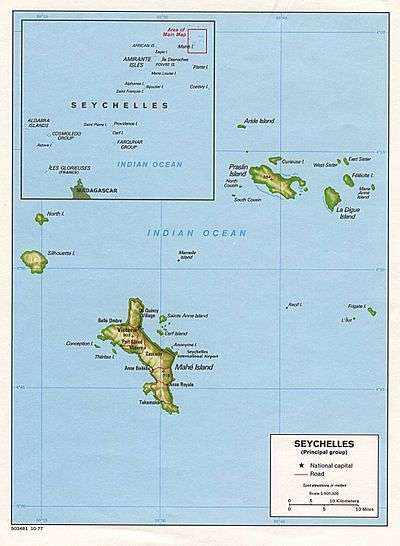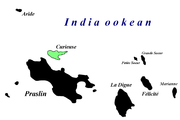Curieuse Island
| Nickname: Ile Rouge | |
|---|---|
|
| |
| Geography | |
| Location | Seychelles, Indian Ocean |
| Coordinates | 4°16′48″S 55°44′48″E / 4.28000°S 55.74667°ECoordinates: 4°16′48″S 55°44′48″E / 4.28000°S 55.74667°E |
| Archipelago | Inner Islands, Seychelles |
| Adjacent bodies of water | Indian Ocean |
| Total islands | 1 |
| Major islands |
|
| Area | 2.93 km2 (1.13 sq mi) |
| Length | 3.6 km (2.24 mi) |
| Width | 1.6 km (0.99 mi) |
| Coastline | 11.5 km (7.15 mi) |
| Highest elevation | 172 m (564 ft) |
| Highest point | Mont Curieuse |
| Administration | |
| Group | Inner Islands |
| Sub-Group | Granitic Seychelles |
| Sub-Group | Praslin Islands |
| Districts | Baie Sainte Anne |
Largest settlement |
Park rangers station (population 7) |
| Demographics | |
| Demonym | Creole |
| Population | 7 (2014) |
| Pop. density | 2.4 /km2 (6.2 /sq mi) |
| Ethnic groups | Creole, French, East Africans, Indians. |
| Additional information | |
| Time zone | |
| Official website |
www |
| ISO Code = SC-07 | |
Curieuse Island is a small granitic island 1.13 sq mi (2.9 km2) in the Seychelles close to the north coast of the island of Praslin. Curieuse is notable for its bare red earth intermingled with the unique coco de mer palms, one of the cultural icons of the Seychelles, only growing on the two neighboring islands.
History
Originally named "Ile Rouge" due to its red coloured soil.[1] In 1768 the French claimed possession of the island, naming it after the schooner "La Curieuse", a ship that was under the command of explorer Marc-Joseph Marion du Fresne. Like a number of islands in the Seychelles, there was a native giant tortoise population that was quickly extirpated.
In 1771 sailors set fire to the island, intending to make harvesting of the coco de mer nuts easier. The fire destroyed many of the islands' native trees, and indications of the fire can still be seen today, nearly 250 years later.[2]
In 1829, Curieuse was first used as a leper colony, and it functioned in this capacity until 1965. This helped protect the ecosystem from human influence. Today, ruins of the leprosarium remain, as well as the former physician's residence at Anse St. Joseph (now an educational center and museum).
Conservation
In 1967 a fire destroyed much of the vegetation on the island, including more than 150 coco de mer palms. Following this event, the government took ownership of the island and introduced various restoration and conservation projects.
In 1979, Curieuse and surrounding waters were declared the Curieuse Marine National Park in order to protect the native wildlife. Between 1978 and 1982, a conservation project relocated Aldabra giant tortoise from Aldabra to Curieuse. Today, it is the home of more than 300 Aldabra giant tortoise, some staying around the Ranger's Station and the rest roaming around elsewhere on the island.
On the southern part of the island is a mangrove swamp that is traversed by a walkway for park visitors. The island is also known for coco de mer palms, giant takamaka trees, a large hawksbill turtle rookery and several bird species, such as the rare Seychelles black parrot Coracopis nigra barklyi, a parrot found only here and on Praslin. Among the plant species on the island, several are native and endemic to Curieuse; Porcher (Cordia subcordata), Bois Chandelle (Dracaena), Lalyann dile (Secamone schimperiana, Bwa bannann (Gastonia sechellarum) and Bois Cassant de Bord Mer (Guettarda speciosa)
Most visitors to the Curieuse Marine National Park disembark at Baie Laraie, where the shallow water is known for its population of large humphead parrotfish, growing up to 1.2 m in length. There is a trail from Baie Laraie to Anse St. José on the other side of the island passing over the boardwalk through the thick mangrove forest. The ruins of the leper colony is now well blended into the landscape and includes Creole colonial architecture which consists of a doctor's house built for Dr. William Macgregor in 1973, now turned into a museum containing information about Curieuse Island's history.[3] On the beach in front of the Doctor's House, sea turtles lay their eggs. There is also currently a satellite camp for the Seychelles branch of Global Vision International, a volunteer group that focuses on conservation of the island and surveys local fish, coral, turtle and coco de mer numbers.[4][5][6]
Image gallery
- Laraie Bay on Curieuse
- Aldabra giant tortoise living in Curieuse Marine National Park
 Map 1
Map 1 Map 2
Map 2 image
image
References
- ↑ seychelles.travel. "The Islands of the Seychelles - Curieuse". Retrieved 2016-03-16.
- ↑ Carpin, Sarah,(1998) Seychelles, Odyssey Guides, p.141, , The Guidebook Company Limited, Retrieved on June 22, 2008
- ↑ Carpin, Sarah,(1998) Seychelles, Odyssey Guides, p.141, , The Guidebook Company Limited, Retrieved on June 22, 2008
- ↑ national park site
- ↑ Ranger station
- ↑ accommodation
| Wikimedia Commons has media related to Curieuse. |